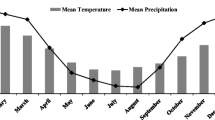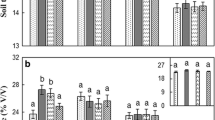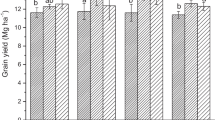Abstract
Intercrop systems can exhibit unique soil properties compared to monocultures, which influences the microbially-mediated processes leading to greenhouse gas emissions. Fertilized intercrops and monocultures produce different amounts of N2O, CO2 and CH4 depending on their nutrient and water use efficiencies. The objective of this study was to compare the fluxes and seasonal emissions of N2O, CO2, and CH4 from a maize–soybean intercrop compared to maize and soybean monocultures, in relation to crop effects on soil properties. The experiment was conducted during 2012, 2013 and 2014 at the WuQiao Experimental Station in the North China Plain. All cropping systems received urea-N fertilizer (240 kg N ha−1 applied in two split applications). The cropping systems were a net source of CO2 and a net sink of CH4, with significantly (P < 0.05 in 2012) and numerically (2013 and 2014) lower N2O flux and smaller seasonal N2O emissions from the maize–soybean intercrop than the maize monoculture. The proportion of urea-N lost as N2O was lower in the maize–soybean intercrop (1.6% during the 3-year study) and soybean monoculture (1.7%), compared to maize monoculture (2.3%). Soybean reduced the soil NO3−–N concentration and created a cooler, drier environment that was less favorable for denitrification, although we cannot rule out the possibility of N2O reduction to N2 and other N compounds by soybean and its associated N2-fixing prokaryotes. We conclude that maize–soybean intercrop has potential to reduce N2O emissions in fertilized agroecosystems and should be considered in developing climate-smart cropping systems in the North China Plain.





Similar content being viewed by others
References
Broughton EI, Walker DG (2010) Policies and practices for aquaculture food safety in China. Food Policy 35:471–478. https://doi.org/10.1016/j.foodpol.2010.05.007
Castaldi S (2000) Responses of nitrous oxide, dinitrogen and carbon dioxide production and oxygen consumption to temperature in forest and agricultural light-textured soils determined by model experiment. Biol Fertil Soils 32:67–72. https://doi.org/10.1007/s003740000218
Chen X, Cabrera ML, Zhang L, Wu J, Shi Y, Yu WT, Shen SM (2002) Nitrous oxide emission from upland crops and crop-soil systems in northeastern China. Nutr Cycl Agroecosyst 62:241–247
Cheng XF, Zhang FY (2010) Present conditions and countermeasures of soybean production in Huang-Huai-Hai Regions. Soybean Sci 1:041 (in Chinese)
Dyer L, Oelbermann M, Echarte L (2012) Soil carbon dioxide and nitrous oxide emissions during the growing season from temperate maize–soybean intercrops. J Plant Nutr Soil Sci 175:394–400
Feng J-Y, Chen L, Xu L, Wang SX, Guo GF (2012) Production status, breeding objectives and breeding ways of summer corn in Huanghuaihai Region. J Hebei Agric Sci 10:011 (in Chinese)
Gaillard R, Duval BD, Osterholz WR, Kucharik CJ (2016) Simulated effects of soil texture on nitrous oxide emission factors from corn and soybean agroecosystems in Wisconsin. J Environ Qual 45:1540–1548. https://doi.org/10.2134/jeq2016.03.0112
Gao Y, Duan AW, Qiu XQ, Liu ZG, Sun JS, Zhang JP, Wang HZ (2010) Distribution of roots and root length density in a maize/soybean strip intercropping system. Agric Water Manag 98:199–212
Ghanbari A, Dahmardeh M, Siahsar BA, Ramroudi M (2010) Effect of maize (Zea mays L.)–cowpea (Vigna unguiculata L.) intercropping on light distribution, soil temperature and soil moisture in and environment. J Food Agric Environ 8:102–108
Hanson PJ, Edwards NT, Garten CT, Andrews JA (2000) Separating root and soil microbial contributions to soil respiration: a review of methods and observations. Biogeochemistry 48:115–146
Havlin JL, Beaton JD, Tisdale SL, Nelson WL (2014) Soil fertility and fertilizers: an introduction to nutrient management, 8th edn. Pearson Prentice Hall, Upper Saddle River
Huang JX, Chen YQ, Sui P, Nie SW, Gao WS (2014) Soil nitrous oxide emissions under maize-legume intercropping system in the North China Plain. J Integr Agric 13:1363–1372. https://doi.org/10.1016/S2095-3119(13)60509-2
Iqbal J, Hu RG, Du LJ, Lan L, Shan L, Tao C, Ruan LL (2008) Differences in soil CO2 flux between different land use types in mid-subtropical China. Soil Biol Biochem 40:2324–2333. https://doi.org/10.1016/j.soilbio.2008.05.010
Itakura M et al (2013) Mitigation of nitrous oxide emissions from soils by Bradyrhizobium japonicum inoculation. Nat Clim Change 3:208–212. https://doi.org/10.1038/Nclimate1734
Jensen ES, Peoples MB, Boddey RM, Gresshoff PM, Hauggaard-Nielsen H, Alves BJR, Morrison MJ (2012) Legumes for mitigation of climate change and the provision of feedstock for biofuels and biorefineries. A review. Agron Sustain Dev 32:329–364. https://doi.org/10.1007/s13593-011-0056-7
Ju XT et al (2011) Processes and factors controlling N2O production in an intensively managed low carbon calcareous soil under sub-humid monsoon conditions. Environ Pollut 159:1007–1016. https://doi.org/10.1016/j.envpol.2010.10.040
Koch O, Tscherko D, Kandeler E (2007) Temperature sensitivity of microbial respiration, nitrogen mineralization, and potential soil enzyme activities in organic alpine soils. Global Biogeochem Cycles. https://doi.org/10.1029/2007gb002983
Kuzyakov YV, Larionova AA (2006) Contribution of rhizomicrobial and root respiration to the CO2 emission from soil (a review). Eurasian Soil Sci 39:753–764
Latati M, Blavet D, Alkama N, Laoufi H, Drevon JJ, Gérard F, Pansu M, Ounane SM (2014) The intercropping cowpea-maize improves soil phosphorus availability and maize yields in an alkaline soil. Plant Soil 385:181–191. https://doi.org/10.1007/s11104-014-2214-6
Li L, Rengel Z (2012) Soil acidification as affected by phosphorus sources and interspecific root interactions between wheat and chickpea commun. Soil Sci Plan 43:1749–1756. https://doi.org/10.1080/00103624.2012.684821
Li CJ, Li YY, Yu CB, Sun JH, Christie P, An M, Zhang FS, Li L (2011) Crop nitrogen use and soil mineral nitrogen accumulation under different crop combinations and patterns of strip intercropping in northwest China. Plant Soil 342:221–231. https://doi.org/10.1007/s11104-010-0686-6
Luan JW, Wu JH (2015) Long-term agricultural drainage stimulates CH4 emissions from ditches through increased substrate availability in a boreal peatland. Agric Ecosyst Environ 214:68–77. https://doi.org/10.1016/j.agee.2015.08.020
Mahmood T, Ali R, Malik KA, Aslam Z, Ali S (2005) Seasonal pattern of denitrification under an irrigated wheat-maize cropping system fertilized with urea and farmyard manure in different combinations. Biol Fertil Soils 42:1–9. https://doi.org/10.1007/s00374-005-0869-0
Marhan S, Auber J, Poll C (2015) Additive effects of earthworms, nitrogen-rich litter and elevated soil temperature on N2O emission and nitrate leaching from an arable soil. Appl Soil Ecol 86:55–61. https://doi.org/10.1016/j.apsoil.2014.10.006
Miao SJ, Zhou KQ, Sui YY, Zhang XY, Liu XB (2015) Impact of eight-year topsoil removal and soil amendments on soil carbon dioxide emission in an eroded Chinese mollisols. Agron J 107:1280–1286
Mitchell RL, Russell WJ (1971) Root development and rooting patterns of soybean (glycine-max (l) merrill) evaluated under field conditions. Agron J 63:313–316. https://doi.org/10.2134/agronj1971.00021962006300020034x
Robinson A, Di HJ, Cameron KC, Podolyan A, He JZ (2014) The effect of soil pH and dicyandiamide (DCD) on N2O emissions and ammonia oxidiser abundance in a stimulated grazed pasture soil. J Soils Sediments 14(8):1434–1444. https://doi.org/10.1007/s11368-014-0888-2
Siciliano SD (2014) Identification of regulatory genes to reduce N2O production. Can J Plant Sci 94:1033–1036. https://doi.org/10.4141/Cjps2013-216
Tang CX, Weligama C, Sale P (2013) Subsurface soil acidification in farming systems: its possible causes and management options. Progr Soil Sci. https://doi.org/10.1007/978-94-007-4177-5_13
Vieten B, Conen F, Seth B, Alewell C (2007) The fate of N2O consumed in soils. Biogeosci Discuss 4:3331–3341
Yamazaki T, Yoshida N, Wada E, Matsuo S (1987) N2O reduction by Azotobacter vinelandii with emphasis on kinetic nitrogen isotope effects. Plant Cell Physiol 28:263–271
Zhai LM, Liu HB, Zhang JZ, Huang J, Wang BR (2011) Long-term application of organic manure and mineral fertilizer on N2O and CO2 emissions in a red soil from cultivated maize-wheat rotation in China. Agric Sci China 10:1748–1757
Zhang FS, Li L (2003) Using competitive and facilitative interactions in intercropping systems enhances crop productivity and nutrient-use efficiency. Plant Soil 248:305–312
Acknowledgements
This study was supported by the National Key Research and Development Program of China (2016YFD0300210 and 2016YFD0300203). YS acknowledges financial support from the China Scholarship Council (CSC).
Author information
Authors and Affiliations
Corresponding authors
Electronic supplementary material
Below is the link to the electronic supplementary material.
A1
Seasonal variation in soil water content from maize, soybean and maize–soybean intercrop from 2012 to 2014 (EPS 16565 kb)
A2
Seasonal variation in soil NO3−–N concentration from maize, soybean and maize–soybean intercrop from 2012 to 2014 (EPS 16096 kb)
A3
Seasonal variation in soil temperature from maize, soybean and maize–soybean intercrop from 2012 to 2014 (EPS 16576 kb)
A4
Seasonal variation in soil dissolved organic carbon concentration from maize, soybean and maize–soybean intercrop from 2012 to 2014 (EPS 14748 kb)
A5
Seasonal variation in soil pH from maize, soybean and maize–soybean intercrop from 2012 to 2014 (EPS 14715 kb)
A6
Seasonal variation in soil NH4+–N concentration from maize, soybean and maize–soybean intercrop from 2012 to 2014 (EPS 16163 kb)
A7
Soil properties in plots cultivated with maize, soybean and maize–soybean intercrop, averaged across three growing seasons (2012) at the Wu Qiao Experimental Station, Cangzhou, China. Data are box and whisker plots, where boxes represent data between the 25th and 75th percentiles and show the median (solid line) and mean (dotted line) values for each soil parameter. The whiskers are error bars representing values falling in the 10th and 90th percentiles of the distribution (EPS 8274 kb)
A8
Soil properties in plots cultivated with maize, soybean and maize–soybean intercrop, averaged across three growing seasons (2013) at the Wu Qiao Experimental Station, Cangzhou, China. Data are box and whisker plots, where boxes represent data between the 25th and 75th percentiles and show the median (solid line) and mean (dotted line) values for each soil parameter. The whiskers are error bars representing values falling in the 10th and 90th percentiles of the distribution (EPS 8877 kb)
A9
Soil properties in plots cultivated with maize, soybean and maize–soybean intercrop, averaged across three growing seasons (2014) at the Wu Qiao Experimental Station, Cangzhou, China. Data are box and whisker plots, where boxes represent data between the 25th and 75th percentiles and show the median (solid line) and mean (dotted line) values for each soil parameter. The whiskers are error bars representing values falling in the 10th and 90th percentiles of the distribution (EPS 8877 kb)
Rights and permissions
About this article
Cite this article
Shen, Y., Sui, P., Huang, J. et al. Greenhouse gas emissions from soil under maize–soybean intercrop in the North China Plain. Nutr Cycl Agroecosyst 110, 451–465 (2018). https://doi.org/10.1007/s10705-018-9908-8
Received:
Accepted:
Published:
Issue Date:
DOI: https://doi.org/10.1007/s10705-018-9908-8




